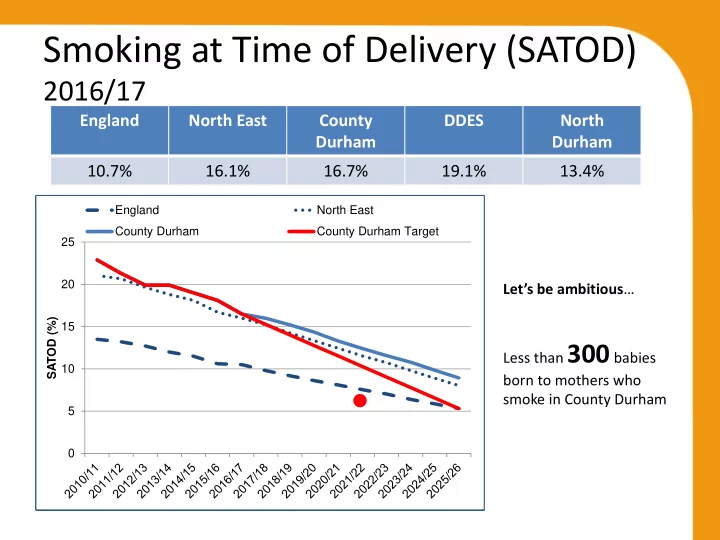

Smoking at Time of Delivery (SATOD) 2016/17 England North East County DDES North Durham Durham 10.7% 16.1% 16.7% 19.1% 13.4% England North East England England North East North East County Durham England North East County Durham 2016/17 2025/26 County Durham County Durham Target County Durham 25 25 25 25 900 babies born to 460 babies born to 20 20 20 20 Let’s be ambitious … mothers who smoke. mothers who smoke. SATOD (%) SATOD (%) SATOD (%) SATOD (%) 15 15 15 15 If County Durham had the If County Durham had the Less than 300 babies same % SATOD as England same % SATOD as England 10 10 10 10 born to mothers who there would be around there would be around smoke in County Durham 340 less babies born to 180 less babies born to 5 5 5 5 smoking mothers. smoking mothers. 0 0 0 0 2010/11 2011/12 2012/13 2013/14 2014/15 2015/16 2016/17
SATOD by MSOA and deprivation 3 year pooled 2014/15 – 2016/17 40 35 30 25 % SATOD 20 15 10 5 0 0 10 20 30 40 50 60 Deprivation Score Least deprived (ID2015) Most deprived There are 66 MSOAs (middle super output areas) in County Durham with an average population of around 7,200.
SATOD by MSOA North Durham 3 year pooled 2014/15 – 2016/17 North Durham North Durham +/- 20% 30 25 % SATOD 20 15 10 5 0 30% most deprived Not deprived
SATOD by MSOA DDES 3 year pooled 2014/15 – 2016/17 DDES DDES +/- 20% 40 35 30 % SATOD 25 20 15 10 5 0 30% most deprived Not deprived
Smoking in Pregnancy incentive scheme DDES Specific goals: • To support pregnant smokers to set a quit date and achieve a CO validated 4-week quit, • To remain smokefree throughout the pregnancy and for 3-months post-partum. Key elements: • Enhanced cessation support • A financial incentive/ reward for achieving and maintaining smokefree status • Support from a Significant Other (SOS) Taping. D, Bauld. L. Purves, D. et al, (2015) Financial incentives for smoking cessation in pregnancy: randomised controlled trial. BMJ 2015;350:h134 doi: 10.1136/bmj.h134
Criteria Women are recruited via health professional referral based on the following criteria: • Teen pregnancy • Living in an area of deprivation/high smoking prevalence • Living with a smoker/s • Smoked throughout previous pregnancy • Judgement of the relevant health care professional
Outcomes • 122 women to go through the programme • based on the success of previous evaluation data, it is expected that 69% (n=84) women are quit at 4 weeks, and • 71% (n=59) would still be quit at delivery
Recruitment as of Q2 (April – Sept) Target 122: Recruited 92 • 36% (n=33) have identified a significant other. • 64% (n=58) are participating in the scheme unsupported by a significant other • 40% of women unsupported by a significant other live with a smoker. Within this cohort 47% were lost to follow-up or did not quit • 14% (n=13) of those participating in the scheme are teenagers • 46% (n=42) are age 25yrs or above
Continued… • 8% (n=44) participants have identified themselves as never having worked or having been unemployed for over a year • 35% (n=32)as routine and manual workers • Overall just under 84% are routine manual have never worked or are long-term unemployed – These women would be classified as the most vulnerable
Great success once women engage with the Stop Smoking Service 2016/17 Number Number setting Number quit Number quit with Total quit referred to SSS a quit date Midwife BI 920 211 117 66 183
Quarter 1 service results Q1 2016-17 Q1 2017-18 Total pregnancy referrals 217 331 Midwife referrals 193 309 Attended appointment 81 (37%) 136 (41%) Set a quit date 58 (72%) 59 Quit at 4 weeks 35 (60%) 40 (68%) CO validated quits 30 (86%) 34 (85%) Q1 2016-17 Q1 2017-18 DDES North Durham DDES North Durham Set a quit date 33 23 41 18 Quit at 4 weeks 19 (58%) 16 (70%) 29 (73%) 11 (61%) CO validated quits 15 (79%) 15 (94%) 27 (93%) 7 (64%)
Quarter 2 service results Q2 2017-18 Q2 2016-17
Healthwatch – Maternity Report • Healthwatch County Durham (HWCD) undertook engagement and research on to help ND and DDES CCGs understand experiences of smoking during pregnancy • Key Performance Indicator (KPIs) for maternity services – Women smoking at time of delivery (per 100 maternities)
Engagement and Research Undertaken The approach was split into two areas of work: 1. Gathered the views and experiences of mothers in County Durham in relation to their smoking behaviour whilst pregnant. 2. Contact demographically similar CCG areas where they are higher achieving in relation to the performance indicator with a view to identify positive initiatives or/and best practice.
Key Themes / Feedback • Early intervention is key • Women do generally understand the risks to themselves and their babies • 97% of women surveyed felt had the information provided to them on the effects of smoking on their unborn baby was helpful and easy to understand. • 67% felt they were given support they needed to stop smoking, however of those referred to the stop smoking scheme, 50% did not attend appointments and 40% did not want to go.
Recommendations from HWCD for consideration • Methods adopted by similar CCGs – early intervention and access to nicotine replacement therapy from the initial booking appointment • Carbon monoxide level testing to be carried out at all booking appointments and where there is a raised level is raised, an immediate referral made by midwife to the stop smoking services by telephone. • Stop smoking support is maintained postnatally, at a time when smoking is likely to re-commence. • A ‘buddying’ network with non smoking family members and friends who can offer support • Enhanced support packages for higher deprivation and rural communities
Recommend
More recommend